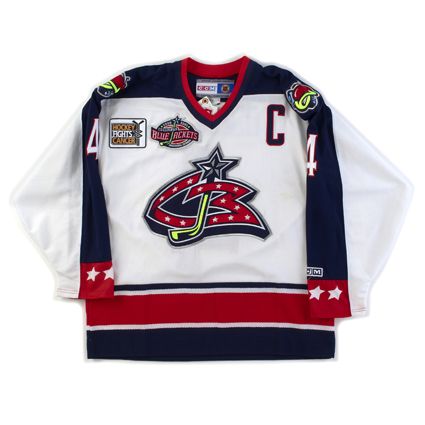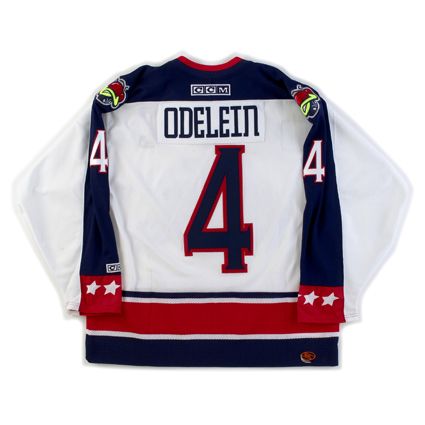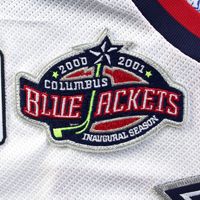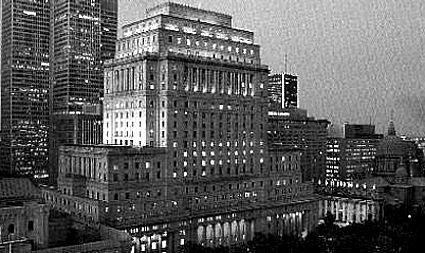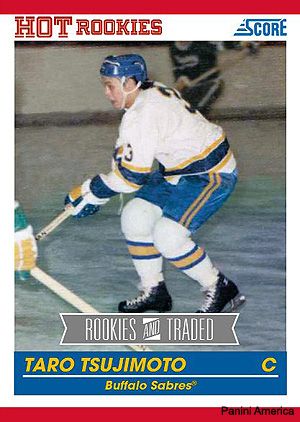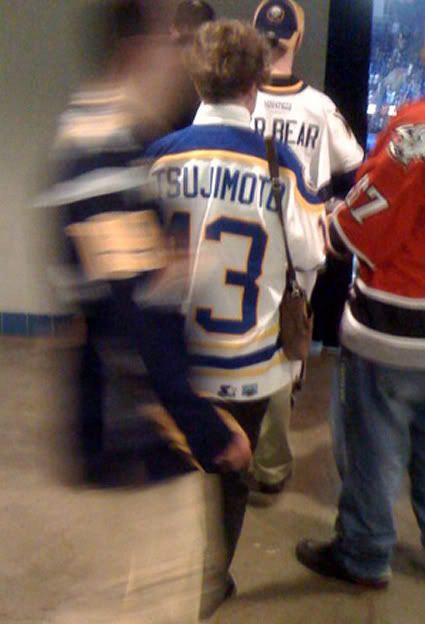Saturday, June 27, 2009
1998-99 Tampa Bay Lightning Alternate Vincent Lecavalier Jersey
Vincent Lecavalier was selected first overall on this date by the Tampa Bay Lightning in the 1998 NHL Entry Draft.
In his two seasons in the Quebec Major Junior Hockey League, Lecavalier had 86 goals and 131 assists for 217 points in 122 games. He was only the fifth player from the QMJHL to be picked first overall after Guy LaFleur, Mario Lemieux, Pierre Turgeon and Alexandre Daigle.
In March of 2000, he was made the youngest captain in NHL history at 19 years and 11 months old, surpassing the old record of 21 years, 5 months held by Steve Yzerman.
In 2003-04 the Lighting won the Southeast Division, distancing themselves from the rest of the teams by 28 points, the total of all the other division winners margins combined. In the playoffs, they defeated the New York Islanders 4 games to 1 and then swept the Montreal Canadiens 4-0.
The Philadelphia Flyers proved a much tougher foe, with the series going the full seven games before Tampa prevailed by the closest of margins, 2-1, at home to move onto face the Calgary Flames in the finals, which would also go seven games and again Tampa would prevail by a 2-1 score in the deciding Game 7 to win the Stanley Cup, with Lecavalier getting the assist on the game winning goal.
Lecavalier was then a late addition to Team Canada for the 2004 World Cup of Hockey and would go onto be named the tournament MVP after scoring seven points in six games, including the game winning goal in overtime versus the Czech Republic in the semi-finals.
His whirlwind year would not stop there however. Immediately after the World Cup, the NHL owners would lockout the players in a labor dispute and Lecavalier would travel to Russia to play for Ak Bars Kazan in the Russian Superleague along with 11 other NHLers.
Lecavalier would score his 500th career point and capture the Maurice Richard Trophy while achieving a career high 52 goal, 108 point season in 2006-07.
The jersey I am featuring today is a CCM 1998-99 Tampa Bay Lightning Alternate Vincent Lecavlaier jersey as worn by Lecavalier during the first two months of his rookie season. This rare third jersey, which depicts a dramatic storm at sea, with pelting rain and crashing waves, along with jagged lightning bolts running down each arm, has the 1999 NHL All-Star Game patch as worn in Lecavalier's rookie season and also sports the #8 he started his career with before changing to his customary #4 the next season.
The Lightning, for some unknown reason, started off the 98-99 season using their usual home and road jersey paintbrush font, "Reporter", for the numbers on the alternate jersey instead of the more fitting "electric" numbers originally used in the 96-97 and 97-98 seasons with the alternate jersey, only to switch back to the more fitting "electric" numbers at some point after mid-November.
Even after the welcome change in font for the numbers, there is photographic evidence of the captain's C and assistant captain's A's still remaining in the now mismatched paintbrush font. We are uncertain if they ever reverted to the "electric" font for the C's and A's at any point in the 98-99 season, the last for this alternate style.
While many people lump this alternate jersey in with some of the other hideous third jerseys of the mid-90's, we actually like this one very much. Perhaps the lightning bolts on the arms are a bit over done, but we love the body of the jersey with the rain, waves and and the bold, vertically arched font for the name, especially when properly mated with the original electric number font.
Labels:
Lecavalier,
Tampa Bay Lightning
Friday, June 26, 2009
1984-85 Pittsburgh Penguins Mario Lemieux Jersey
Today is the 2009 NHL Entry Draft, being held in Montreal as part of the Montreal Canadiens centennial celebrations. It can be seen live on Versus in the USA and TSN in Canada starting at 7 PM Eastern time.
The NHL draft began in 1963 and was instituted by NHL President Clarence Campbell in an attempt to give all the teams a fighting chance to acquire star players by replacing the old system, where teams would scout and then "sponsor" young players, locking in those players and denying the other clubs any chance of acquiring them, such as the case with Bobby Orr who was signed by the Boston Bruins at age 14.
Under the rules of the new draft system, only players age 16 were eligible and teams were not allowed to even talk to their drafted players about turning professional until they turned 18. In 1969 the rules were changed so that any player under the age of 20 could be drafted, which resulted in more than four times the average number of players being picked than the previous six drafts.
The name of the draft was changed to the "NHL Entry Draft" in 1979 to coincide with a rule change that allowed players who had previously played professionally to be drafted, which gave teams the chance to pick players who had been part of the defunct World Hockey Association. The next season, without competition from the WHA, the rules were amended so that any player between the ages of 18 and 20 could be drafted and any non-North American player over the age of 20 was now eligible.
In 2003, the Florida Panthers attempted to circumvent the rules and draft Alexander Ovechkin, even though his birthday was two days after the cut-off date for eligibility for that year's draft. Then Panthers General Manager Rick Dudley, claiming that with the extra addition of leap days since Ovechkin was born made him eligible to be drafted.
The jersey I am featuring today is a CCM 1984-85 Pittsburgh Penguins Mario Lemieux Sunday Alternate jersey, worn by Lemieux during his rookie season after being the first overall player taken in the 1984 NHL Entry Draft.
The older Penguins jerseys have some detail changes when compared to the jerseys worn during their Stanley Cup winning seasons. First, the numbers are located up on the shoulders in the yellow area, rather than down lower on the arms in the black area where they would be relocated in 1988. The other notable differences to the early examples of this style jersey are the serif font used for the names on the back, the slightly thinner font used for the back numbers and taller font used for the numbers on the arms.
Lemieux would kick off his career in grand style, scoring a goal on his first ever shot on goal in the first shift of his first game. He would go on to win the Calder Memorial Trophy the year he wore this style yellow jersey as well as his first All-Star Game MVP award, the first ever rookie to do so.
Labels:
Lemieux,
Pittsburgh Penguins
Thursday, June 25, 2009
2000-01 Columbus Blue Jackets Lyle Odelein Jersey
It was on this date in 1997 that the NHL officially approved expansion to a 30-team league by the year 2000. In an unusual plan, the Nashville Predators began play in 1998-99 and the Atlanta Thrashers started life the following season in 1999-2000. Then, the Minnesota Wild and Columbus Blue Jackets completed the exten by joining the league for the 2000-01 season, nearly three and a half years after being granted franchises.
The Columbus franchise selected the name "Blue Jackets", a nickname for the Union soldiers in the Civil War, to honor the contributions made by the state of Ohio during the Civil War, including the fact that Ohio contributed more of it's population to the Union Army than any other state and that many of the Union uniforms were also manufactured in Columbus.
Columbus started out life in the NHL with a rough go, finishing last in the Central Division in each of it's first three seasons and averaging only 69 points in it's first seven, missing the playoffs each time out.
Things finally look to be improving for the Blue Jackets however. This past season they made the playoffs for the first time after a 92 point season, the last of the current teams to qualify for the postseason.
They are led by the franchise's all-time leading scorer Rick Nash, who arrived in time for the 2002-03 season after being drafted #1 overall in the 2002 Entry Draft. Nash tied for the league lead in goals with 41 during the 2003-04 season, earning a share of the Rocket Richard Trophy in just his second season in the league. Goaltender Steve Mason adds to the brighter outlook for the Blue Jackets, earning the Calder Memorial Trophy for his stellar debut season in 2008-09.
Today's featured jersey is a 2000-01 Columbus Blue Jackets Lyle Odelein jersey. It features the Blue Jackets Inaugural Season patch, as well as one of our custom made Hockey Fights Cancer patches. Odelein was selected by the Blue Jackets in the 2000 expansion draft and later named the first captain of the franchise.
The Hockey Fights Cancer patch was first worn by the captain of each team for one game only in January of 2001. The patches from 2001 do not carry the date, as they did in the subsequent three years of the program. Each specially patched game worn jersey would then be auctioned off for charity as part of the festivities at that year's NHL All-Star Game to raise money for cancer research.
Dasherboard: When the Nashville Predators joined the league in 98-99, a major realignment of the divisions took place, expanding from two six and two seven team divisions, to six divisions, some with as few as four teams. The Predators came out fine in this plan, being grouped in with established nearby clubs in Detroit, Chicago and St. Louis.
Atlanta was added to the Southeast Division, centrally located between Washington and Carolina to the north and the two Florida clubs, Tampa Bay and Florida, who played in the Miami area, to the south.
Columbus fit in naturally with Nashville in the Central Division when they joined the league, but due to the increased number of teams in the east, Minnesota was slotted in with the teams in the Northwest Division - Colorado, Edmonton, Calgary and Vancouver - none of whom are even in their time zone and most of which aren't even in the same country!
The other victim of the realignment was the Dallas Stars, who were inexplicably placed in the Pacific Division - 885 miles from their nearest division neighbor and over 1900 miles from said Pacific Ocean after which their division was named...
Labels:
Columbus Blue Jackets,
Odelein Lyle
Wednesday, June 24, 2009
La Fête Nationale du Québec
La Fête nationale du Québec, the national holiday of the Canadian province of Quebec is celebrated annually on June 24th, St. John the Baptist Day.
The feast day of St. John the Baptist, celebrating the birth of Jesus' cousin, was a very popular event in France from the 14th to 18th centruries and migrated to Canada with the first French colonists as far back as 1636.
Inspired by the 1834 St. Patrick's Day celebrations in Montreal, the publisher of the newspaper La Minerve, Ludger Duvernay got the idea to organize a similar event for French Canadians. In addition to the traditional bonfires of St. John the Baptist Eve, parades were eventually organized and became part of the tradition as well.
In 1843, Duvernay established the St. John the Baptist Society to promote French-Canadian interests within Canada and preserve the French language and culture and Roman Catholic religion. In 1880 the society organized a gathering of all French communities across North America, the National Congress of French Canadians. It was at this gathering that "O Canada" was first performed. Based on a poem by Adolphe-Basile Routhier, the song was commissioned by Théodore Robitaille. An English translation did not appear until 1906 and it was not until 1908 that Robert Stanley Weir wrote an English version, which was not a translation of the French lyrics.
"O Canada" would not officially become Canada's national anthem until 1980.
In 1908, Pope Pius X designated St. John the Baptist as the patron saint of French Canadians and in 1925, June 24th became a legal holiday in Quebec for all it's citizens, not just those of French Canadian or Catholic origins.
Just in case you were interested, here is the translation of the French lyrics of "O Canada";
O Canada!
Land of our forefathers
Thy brow is wreathed with a glorious garland of flowers.
As is they arm ready to wield the sword,
So also is it ready to carry the cross.
They history is an epic of the most brilliant exploits.
They valour steeped in faith
Will protect our homes and our rights
Will protect our homes and our rights.
Our featured jersey today is a CCM 1992-93 Quebec Nordiques Joe Sakic jersey from the CCM Vintage Collection Throwback Series. Seeing how much collectors were spending for original Nordiques and Minnesota North Stars jerseys, CCM knew there was an opportunity to make some money by capitalizing on the obvious demand for throwbacks, first introduced during the NHL's 75th Anniversary season of 1991-92 when the Original Six teams all wore throwback jerseys.
Much better quality than the original, undersized and lightweight (to the point of being see-through) replica jerseys of the 80's, many retired styles were remade with the current-for-the-time 550 Series replica model, which provided fans with a very high quality replica for the price.
The Nordiques jersey is by far and away the one NHL jersey from that time period that most represented the flag of the state or province the team played in, and for that reason has always been one of my favorite jerseys.
This jersey also features the rare French version of the Stanley Cup Centennial patch, worn only the the Nordiques and their Quebec neighbors, the Montreal Canadiens, which reads "Coupe Stanley". If you look very closely at the shield on the players chest, you can also see that it reads "LNH" for "Ligue Nationale de Hockey", French, of course, for "NHL".
Sakic was originally chosen 15th overall by the Nordiques at the 1987 draft. He originally wore #88 because his preferred #19 was already taken by Alain Côté, who retired after Sakic's rookie season, allowing Joe to reclaim it in time for his second year. He was first named co-captain in 1990-91, along with Steve Finn, for home games only while Finn was captain on the road. He became the team's sole captain for the 1992-93 season and has remained so ever since.
After finishing last in the entire league for three straight seasons from 1988-89 to 1990-91, Sakic led the improved Nordiques, thanks in no small part to the Eric Lindros trade which brought in Swede Peter Forsberg among others, to the Adams Division title in the 1994-95 season, the team's last in Quebec City.
Yes, that was a quite young Avril Lavigne.
Dasherboard: Congratulations to Steve Yzerman, Brett Hull, Luc Robitaille and Brian Leetch for being named to the Hockey Hall of Fame.
Labels:
Quebec Nordiques,
Sakic
Tuesday, June 23, 2009
2000-01 Spartak Moscow Ilya Kovalchuk Jersey
It was on this date that the Atlanta Thrashers selected Ilya Kovalchuk with the first pick of the 2001 NHL Entry Draft, making him the first Russian ever chosen first overall.
The first Russian ever drafted by an NHL team was Viktor Khatulev, who was drafted by the Philadelphia Flyers in the ninth round, 160th overall, of the 1976 NHL Amateur Draft. He never even learned he was drafted until 1978 and never had the chance to play in North America. He was eventually banned for life from the Soviet hockey league in 1981 for hitting a referee during a fight with another player.
The first Russain in to play in the NHL was Sergei Priakin, the first Soviet player granted permission to do so. Priakin, already a nine year veteran in the Soviet League, lined up for two games for the Calgary Flames at the end of the 1988-89 season after the conclusion of Soviet League season. He was carefully chosen by the Soviet authorities at the time. He was good enough to play in the NHL, but not so good that they could not afford to lose him from the national team. He would represent Soviet hockey and at the same time be used to dangle the carrot of possibly being allowed to play in the NHL in front of the other Soviet players back home. Priakin would play an additional 44 games over the next two seasons for the Flames, before moving back to Europe where he would continue to play another nine seasons in the Swiss, Russain, Finnish and even the Japanese leagues.
Other early Soviet players in the NHL included Viacheslav Fetisov, Igor Larionov and Valdimir Krutov, the first true Soviet stars to fight for the opportunity to play in the NHL. While Krutov did not pan out as an NHLer, Fetisov and Larionov would go onto win the Stanley Cup five times between the two of them, all with the Detroit Red Wings.
Sergei Makarov would also compete in the NHL, and well enough to inspire a rule change. He was named the Calder Trophy winner, given "to the player selected as the most proficient in his first year of competition in the NHL" at the age of 31. The rules for eligibility were were changed so that only players 26 or younger now qualify for the award.
While Fetisov, Larionov and Krutov would be granted permission to play in the NHL, others would take a different route. Both Alexander Mogilny and Sergei Fedorov would defect in order to play in North America. Both chose the year of their escape from the Soviet Union as their jersey numbers, with Mogilny taking #89 and Fedorov #91.
Mogilny would become the first Russian to lead the NHL in goals and reach the 100 point plateau in 1992-93, the year of his amazing 76 goal season, which still stands as the record for most goals in a single season by a Russian player. He would later become not only the first Russian, but the first European of any nationality, to captain an NHL team in 1993-94 with the Buffalo Sabres.
Fedorov would become the first Russian to capture the Hart Trophy, the Selke Trophy and the Pearson Award. He is currently the all-time leading Russian scorer in NHL history with 1179 points.
Prior to Kovalchuk being selected first overall, the three highest drafted Russians were Alexi Yashin, selected by the Ottawa Senators (1992), Oleg Tverdovsky by the Mighty Ducks of Anaheim (1994) and Andrei Zyuzin by the San Jose Sharks (1996), all of whom were selected with the #2 pick overall.
A significant event in the acceptance of Russian players by the North American hockey community was the 1989 election to the Hockey Hall of Fame of long-time Soviet National Team goaltender Vladislav Tretiak, the first European born player without any NHL experience and the first Russian player ever elected to the Hall.
When the New York Rangers won the Stanley Cup in 1994, Sergei Nemchinov, Alexander Karpovtsev, Alexi Kovalev (the first Russian taken in the first round of the draft at #15 overall) and Sergei Zubov became the first Russians to have their names engraved on the Stanley Cup.
Just this year Evgeni Malkin became the first Russian to win the Conn Smythe Trophy.
Today's featured jersey is a Lutch 2000-01 Spartak Moscow Ilya Kovalchuk jersey. Spartak was the team Kovalchuk last played for in Russia before being drafted first overall. The team name across the waist is in Cyrillic as is the city name and Kovalchuk's name on the back. The jersey is dye-sublimated, as are most good quality authentic Russian jerseys.
It's been explained to me that Spartak (named for "Spartacus" the gladiator) was very popular with the Soviet citizens due to the fact that the Spartak hockey and soccer teams were part of the Spartak Moscow sports society, a physical culture and sports society of the workers, compared to rivals Dynamo Moscow, the sporting arm of the Soviet secret police, the KGB, and Central Red Army, the sports club of the Soviet Army. This made Spartak "the people's club" and cheering for them at games was the one chance Soviet fans had to cheer openly against the government in public without fear of reprisals.
Labels:
Kovalchuk,
Russia,
Soviet Union,
Spartak Moscow
Monday, June 22, 2009
Taro Tsujimoto - The Player Who Did Not Exist
In 1974 the NHL Amateur Draft was held via conference call at the NHL office in Montreal, Quebec earlier than normal, and in secret, to prevent the rival World Hockey Association teams from poaching their prospective players. To save on scouting costs, the WHA had a habit of watching the NHL draft and then attempting to sign players the NHL had drafted before the NHL clubs could.
The secrecy didn't work though, as information leaked out via agents and other sources over the three days of the draft. 1974 was also the first year the NHL allowed underage players to be signed in response to the WHA taking players below the current NHL age limit of 20 years old the previous year.
The legend of Taro Tsujimoto lives on, as Score created a hockey card of the imaginary Japanese draft pick in it's 2010-11 Rookies and Traded set!
You can even order your own Toyko Katanas Taro Tsujimoto t-shirt and spot the occasional Tsujimoto jersey, our featured jersey of the day, at Sabres games as the joke lives on 35 years later.
The secrecy didn't work though, as information leaked out via agents and other sources over the three days of the draft. 1974 was also the first year the NHL allowed underage players to be signed in response to the WHA taking players below the current NHL age limit of 20 years old the previous year.
Annoyed and fed up by the tedious conference call format, Buffalo Sabres general manager Punch Imlach decided to have some fun at the expense of the league president Clarence Campbell. Imlach asked one of the secretaries of the front office staff if she knew any common Japanese names similar to "Smith" in English. While she didn't have an immediate answer, she did know a Japanese florist and phoned him. The florist informed her that "Tsujimoto" was a common last name in Japan and "Taro" was common for a first name as well. Imlach got the spelling from her, and then thought for her to ask the florist what the Japanese word was for "sword", to which he answered "katana".
When the Sabres turn arrived in the 11th round, Imlach then claimed star center Taro Tsujimoto of the Tokyo Katanas of the Japanese League as the 183rd overall pick. All along the conference line people started to laugh and someone then asked how "Tsujimoto" was spelled. Not one person in the eighteen clubs listening on the call, perhaps a hundred of the best hockey experts in the business, knew who Taro Tsujimoto was, to the delight of Imlach.
Remember, this was 1974, when Swedish players had just started playing in the NHL and the first Russian NHLer was still 15 years in the future. It would also be 21 years before Japanese players would make their way onto major league baseball rosters with any regularity, so even the thought that a Japanese player would even be drafted, or even make an NHL roster, was simply absurd at the time.
The Sabres at one point even talked about actually getting a Japanese guy to show up at training camp, but did not carry the gag that far. Eventually when they did get to camp, reporters started asking when Taro was going to arrive, to be told, "Any day now."
It wasn't until weeks after the draft that Imlach finally admitted that "Taro Tsujimoto" was a fake pick, but not until the name had appeared in several NHL publications, and all major media had reported it as a legitimate pick, including The Hockey News. The NHL would eventually change the pick to "invalid claim" for it's official record keeping purposes but the Sabres still include Tsujimoto in their official team media guides.
Taro Tsujimoto quickly became an inside joke for Sabres' fans and employees. For years after the incident, fans would chant "We want Taro" when games became one-sided. There were also a series of signs the fans would make with a "Taro says" theme, such as "Taro says Dave Schultz is German for Game Misconduct". There were also bumper stickers made with the "Taro says" theme.
The legend of Taro Tsujimoto lives on, as Score created a hockey card of the imaginary Japanese draft pick in it's 2010-11 Rookies and Traded set!
You can even order your own Toyko Katanas Taro Tsujimoto t-shirt and spot the occasional Tsujimoto jersey, our featured jersey of the day, at Sabres games as the joke lives on 35 years later.
Labels:
Buffalo Sabres,
Imlach Punch,
odd stories,
Tsujimoto Taro
Sunday, June 21, 2009
1996 Germany National Team Jochen Hecht Jersey
Born on this day in 1977 in Mannheim, West Germany, Jochen Hecht is one of the few, but growing number of German-born players in the NHL.
Originally drafted by the St. Louis Blues in the second round of the 1995 NHL Entry Draft, Hecht played two seasons for the Blues, scoring 32 goals before being traded to the Edmonton Oilers where he played in 2000-01. He was then dealt for a pair of second round draft picks to his current club team, the Buffalo Sabres, where he has just completed his sixth season. His best campaign to date saw him score 56 points in 2006-07 and his 22 goals the following season was the first time he reached the 20 goal plateau.
He has also appeared for the German National Team many times, including no less than four times in the World Junior Tournament, six times in the World Championships, the World Cup twice, and the Olympics in both 1998 and 2002. Unfortunately, he was injured in the very last Sabres game before the 2006 Turin Olympics, causing him to miss the tournament, along with Marco Sturm who was also hurt just days before the games, striking a serious blow to the German squad as they went winless in five games (0-3-2) and failed to advance out of the preliminary round.
Hecht was chosen captain of the month for the Sabres in October 2007 and again in February 2008, making him only the second German born player to captain an NHL team after the New York Rangers Walt Tkaczuk.
A quick check of NHL.com shows Chirstian Erhoff, Marcel Goc, Mikhail Grabovski, Jochen Hecht, Olaf Kölzig, Christoph Schubert, Dennis Seidenberg and Marco Sturm as the only regularly active Germans in the NHL, although some may like to point out that Canadian National Team regular Dany Heatley was born in Germany.
Today's jersey is a Nike 1996 German National Team Jochen Hecht road jersey. This was a very difficult jersey to obtain, as we were trying to find one for several years before having to settle for a size medium, purchased form a seller located in that hockey hotbed of England of all places.
We are always attracted to the striking colors of the German National Team jerseys and this one with it's boldly striped arms and waving flag waist stripes is right up there with our favorites. The dynamic look of this jersey is only increased by the unique main crest treatment featuring the player-in-motion effect done in the colors of the German tri-color flag. This jersey is completed with the smaller, 3-inch size 1996 World Cup of Hockey patch which was worn on all the Nike jerseys in the 1996 World Cup.
Slovakia remains the only jersey from the 1996 World Cup we have yet to add to our collection and remains listed in the right hand column of this page in our wantlist section.
Germany finished with a 1-2 record in the European Pool of the 96 World Cup and was defeated in the quarterfinals by Canada by a 4-1 score. Hecht had one goal in Germany's four games played.
Here is a highlight reel of Hecht goals from the 2007-08 season. Apparently the music was chosen from Hecht's personal list of music on Player Tunes, but you just might want to view this one with the sound off...
Labels:
1996 World Cup of Hockey,
Germany,
Hecht
Subscribe to:
Comments (Atom)






